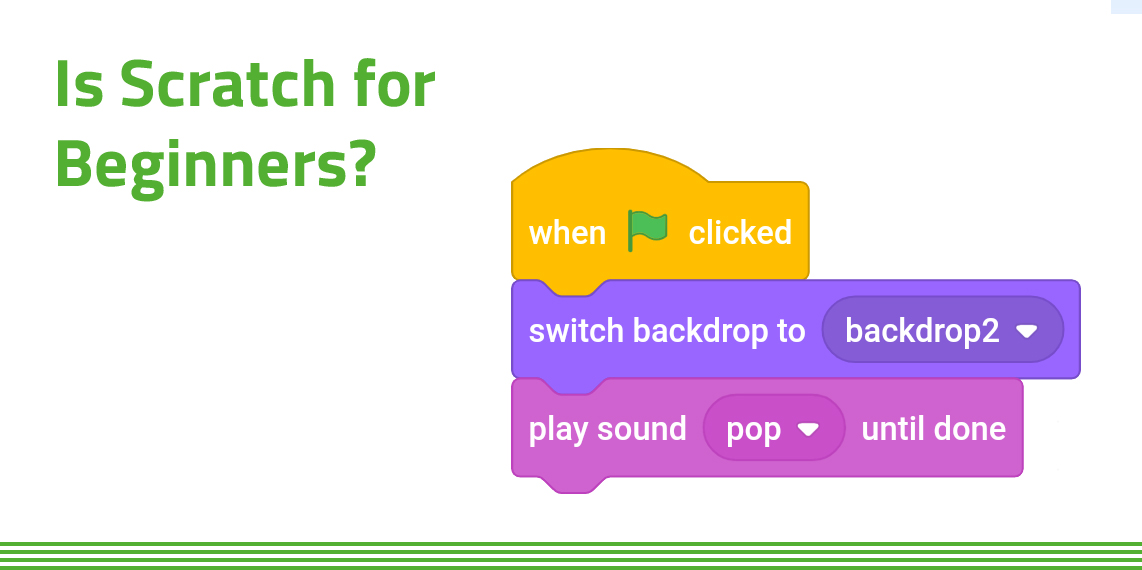We’ve been using the Scratch platform to teach kids programming at our summer camps and online courses for many years. In this time, we’ve seen kids aged 7 and up learn the basics of programming and go on to develop their own games (find out more).
In this short guide we’ll explain how Scratch is easy to learn for beginners and how it can help your child get a head-start in coding.
Is Scratch easy to learn?
Beginners should not find Scratch hard to learn since it is use visual elements and simplified drag and drop functionality. It has been created specifically for kids with the primary purpose of giving them an early exposure to understanding the basics of coding and programming.
Despite the simplicity of Scratch, it is good for learning programming and lets kids create projects that have a relatively high level of complexity as they learn more and more.
Is Scratch good for beginners then?
Scratch is the best introduction to coding for beginners and young kids. In simple terms, it is a block-based programming language which helps to simplify coding for beginners. It uses a drag and drop method which lets children perform actions quickly and easily. This approach is what makes Scratch not hard to learn, and easy to get started with.
Things like omitting a comma and forgetting to close a bracket are eliminated, creating more focus on programming concepts.
After starting out with Scratch, kids will often develop an interest in using more advanced coding languages – here are 4 which are great for kids to start learning once they progress from Scratch.
Even if you don’t intend for your child to become a top-notch programmer and just want them to improve their approach to logical thinking as a beginner, Scratch is a good way to help with this. For example, kids will encounter hurdles in Scratch that they will need to overcome with systematic thinking and problem-solving logic.
Another aspect that makes Scratch good for beginners is you don’t always need a manual to get started. It’s easy enough for most kids to be able to pick it up without any assistance. As they progress and advance, it is helpful to have tuition and guidance, but just starting out is relatively easy.
To make it even easier for beginners, the shape of each block clues the child in on when to use it. There are grooves on blocks. A block can have a groove below or above and use its groove to link with other blocks. A block without a groove signals that links are not possible. Blocks also have colours that enable younger coders to create mental associations with different concepts in computing.
What age is Scratch programming for?
Our Scratch courses are aimed at children aged 7 to 10 years old. We offer programming courses online and as summer camps at a range of UK locations.
With FunTech, kids can use Scratch bring their imagination to life in the form of games, stories and animations. It was developed by MIT Media Lab as a free block-based programming language and is targeted at children who are age 7 years and up and is renowned at helping kids develop creative thinking whilst improving their ability to reason logically.
We find that from the first moments a kid uses Scratch for the first time, it’s the fun element that draws them in. Fun is at the core of what we do, as it’s a great incentive to learn.
Is Scratch good for learning programming?
In the 21st century where technology is progressing at an unprecedented pace, children need to learn how to speak the language of computers. Learning to code has amazing benefits for the mind and future of kids but one challenge parents will often face is deciding what the best medium with which my kids can learn is.
Whilst there is no “right” programming language for kids, the purpose of learning at that age should be focused on fun and problem-solving skills.
Scratch serves as a good building block on the way to using traditional programming languages, so is best considered as an introduction to coding, rather than a “professional” programming language.
When that time comes to advance to something more complex, Scratch will have given your child a valuable head start in learning programming. They can then possibly look at more complex languages. For example, kids who move on to Python will see the parallels with Scratch.
Scratch will help kids to grasp certain programming concepts. These concepts include variables, loops, functions, conditionals and lists. These concepts give kids an understanding of when and how to use them to create a code for their algorithms.
When they understand these and create projects successfully, it becomes easy for them to pick up other programming languages in the future.
Aside from the features that makes Scratch easy to learn is the fact that there are so many online communities dedicated to the platform. Plus of course, there are courses such as the ones we offer at FunTech to help your kids take their skills to the next level.
Learn Scratch with FunTech
We currently offer virtual Scratch lessons and summer camp spaces at various UK locations. You can explore both options on our Scratch Coding page.
Keep me informed
Be the first to know about Flash and Early Bird Sales as well as new courses, summer locations and more.
KEEP ME INFORMED





